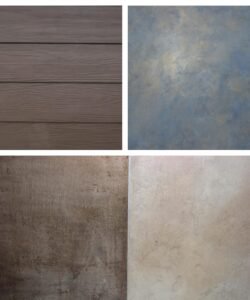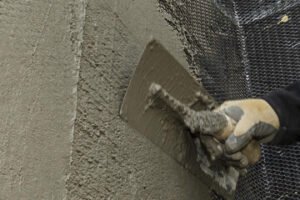Introduction to Interior Paint
Interior paint plays a pivotal role in defining the aesthetics and functionality of indoor spaces. By selecting the right paint, homeowners can transform a dull room into an inviting, visually appealing area. It is not just the color that matters; the type of paint used and its application technique significantly impact the final outcome. Choosing the ideal interior paint involves understanding various factors, from the paint’s composition to its durability and ease of maintenance.
Historically, the use of paint dates back thousands of years. Ancient civilizations utilized natural pigments derived from minerals, plants, and animal sources to adorn their dwellings and public buildings. Over time, paint technology has undergone remarkable evolution. The Renaissance brought a shift towards oil-based paints, which were prized for their rich colors and long-lasting properties. However, it was in the 20th century that interior paint truly revolutionized, thanks to advances in synthetic materials and production processes.
Modern advancements have significantly improved the quality and functionality of interior paints. Today’s options include a plethora of formulations designed to meet specific needs. For instance, water-based latex paints have become popular due to their quick drying time, low odor, and ease of cleanup. On the other hand, oil-based paints are favored for their durability and smooth finish, although they require longer drying times and proper ventilation during application. Additionally, eco-friendly paints have gained traction, offering low-VOC (volatile organic compounds) alternatives that are safer for both occupants and the environment.
Moreover, modern technology has enhanced the application techniques, making it more accessible for both professionals and DIY enthusiasts. Tools such as paint sprayers, rollers with extendable handles, and specialized brushes ensure even coverage and precision. Additionally, advancements in paint formulations have led to the development of self-priming paints and those with integrated sealants, reducing the number of coats required and improving overall efficiency.
Interior paint is more than just a decorative layer; it is a critical component in creating comfortable, harmonious living spaces. By understanding its historical context and modern advancements, individuals can make informed decisions that enhance the appearance and functionality of their homes.

Types of Interior Paint
The selection process for interior paint can be daunting, given the numerous options available in the market. However, understanding the fundamental categories—water-based (latex) and oil-based (alkyd) paints—can simplify this decision significantly.
Water-based, or latex, paints have gained popularity due to their versatility and ease of use. Renowned for their quick-drying characteristics, these paints are ideal for residential interiors. They offer a wide range of finishes, from matte to high gloss, allowing homeowners the freedom to achieve their desired look seamlessly. Additionally, latex paints are generally lower in volatile organic compounds (VOCs), making them an environmentally friendly choice. Their durability on various surfaces, coupled with easy cleanup using water, makes latex paints an excellent choice for living spaces, bedrooms, and other low-traffic areas.
In contrast, oil-based (alkyd) paints are celebrated for their durable, smooth finish which is resistant to both stains and damage. These paints are often selected for high-traffic areas such as kitchens, bathrooms, and hallways. Despite a longer drying time and the need for solvents like turpentine or mineral spirits for cleanup, the robustness of oil-based paints can outweigh these inconveniences for many homeowners. Furthermore, their ability to cover imperfections and create a uniform surface offers significant advantages in spaces prone to wear and tear.
When deciding between water-based and oil-based paints, it is essential to consider the specific needs of the room being painted. For instance, a high moisture area such as a bathroom will benefit from the mildew-resistant properties of certain oil-based paints or specially formulated latex paints designed to withstand humid conditions. Conversely, children’s rooms and living rooms, which require quick turnaround times and non-toxic options, are better served by latex paints.
Ultimately, understanding the differences between latex and oil-based paints, along with evaluating the specific requirements of each room, will guide you in selecting the best interior paint for your home. By considering these factors, you can achieve a perfect balance between aesthetic appeal and functional durability.

Choosing the Right Finish
When selecting interior paint, the finish is a crucial factor that influences both the aesthetic appeal and durability of the painted surface. Paint finishes range from flat to high gloss, each with unique characteristics and suitable applications.
Flat or matte finishes are devoid of any shine and are excellent at hiding wall imperfections due to their velvety texture. However, they are not highly washable, making them a less viable option for high-traffic spaces. Flat finishes work best in adult bedrooms or ceilings where touch-ups are infrequent.
Eggshell finishes offer a subtle sheen and are slightly more durable than flat paints. They strike a balance between appearance and functionality, making them a popular choice for living rooms and dining areas. The modest shine allows for easier cleaning without sacrificing the smooth, elegant look.
Satin finishes provide a soft glow and are more resistant to dirt and grime than both flat and eggshell finishes. Due to its durable and washable nature, satin is ideal for family rooms, children’s bedrooms, and hallways where metallic railings or furniture might cause frequent scuffs.
Semi-gloss finishes are characterized by a noticeable sheen and exceptional durability. These features make semi-gloss paint perfect for high-moisture areas like bathrooms and kitchens. The surface can withstand scrubbing and cleaning, keeping its glossy, clean look over time.
Lastly, high gloss finishes offer maximum sheen and the most robust protection, making it the best choice for high-impact areas prone to dirt and wear. Often used for cabinets, trim, and doors, high gloss finishes underscore architectural features and provide a striking, reflective quality.
In selecting the right finish, consider both the room’s functionality and desired aesthetic. High-traffic, multi-functional areas benefit from durable finishes like satin, semi-gloss, or high gloss, whereas low-traffic spaces can embrace the softer looks provided by flat and eggshell finishes.

Color Psychology and Trends
Choosing the right interior paint color involves more than just selecting your favorite hue. The psychology behind color introduces a significant impact on the mood, energy, and perceived space within each room in your home. Understanding these effects is crucial when aiming to create a specific atmosphere or aesthetic.
Warm colors such as red, orange, and yellow are known to stimulate and energize. Red, for instance, can evoke excitement and passion, making it suitable for areas like dining rooms or living spaces where social interactions occur. Orange is often associated with warmth and enthusiasm. Its use can create inviting spaces such as kitchens or family rooms. Yellow, vibrant and uplifting, is ideal for brightening up dark hallways or small spaces, exuding cheerfulness.
In contrast, cool colors like blue, green, and purple can induce a sense of calm and relaxation. Blue is frequently seen in bedrooms or bathrooms due to its calming effect, fostering peace and tranquility. Green, symbolizing nature and renewal, is versatile and works well in living rooms or home offices, providing a restful and refreshing ambiance. Purple, with its connotations of luxury and creativity, can enhance spaces intended for contemplation or creativity.
Neutral colors remain timeless and versatile, offering a backdrop that complements any style. Shades of white, beige, and gray are ideal for creating a clean, sophisticated look while providing flexibility in pairing with bold accent colors.
Current trends in interior paint reveal a movement towards earthy tones and muted pastels, bringing a sense of serenity and connection to nature. Popular choices include soft blues, sage greens, and warm terracottas, reflecting a desire for coziness and comfort in the home environment.
To effectively use color to create the desired atmosphere, incorporate these guidelines: balance bold colors with neutrals, use lighter shades to make small spaces feel larger, and consider the amount of natural light in a room to enhance or counteract your chosen color’s effects. Striking the right balance in color choices will result in a harmonious and visually appealing home.
Preparation Before Painting
Proper preparation is a critical step to achieving a professional and long-lasting finish when painting any interior space. Start by removing or covering furniture to protect your belongings from paint splatters and dust. Large pieces of furniture should be relocated to another room if possible. If moving them is not an option, utilize drop cloths or plastic sheeting to cover and safeguard them.
Once the room is cleared or protected, proceed to clean the walls. Dust, grease, and dirt can prevent paint from adhering properly, leading to a subpar finish. Use a mixture of mild detergent and water to wipe down the surfaces, ensuring all grime is removed. Pay particular attention to high-touch areas around light switches and door frames.
Inspect the walls for any damage, such as holes, cracks, or peeling paint. Small holes can be filled with a lightweight spackle, while larger repairs might require joint compound. Apply the filler with a putty knife and smooth it out. Allow it to dry completely, then sand it down to achieve a seamless surface. Sanding ensures that these repaired spots are level with the surrounding wall, creating a smooth base for your paint. For areas with peeling paint or rough textures, more extensive sanding or even scraping might be necessary.
Applying a primer is an indispensable step before the actual painting begins. Primer serves several purposes: it seals the wall’s surface, provides a uniform base for paint, and helps in covering the repaired sections more effectively. This is particularly important in rooms with variable wall conditions or when you are making a drastic color change. Choose the primer based on the type of paint you plan to use – water-based or oil-based – to ensure compatibility.
By adhering to these meticulous preparation steps, you set the stage for a flawless painting application that will not only enhance the aesthetic appeal but also ensure durability and longevity of the paint job.

Tools and Materials Needed
Embarking on an interior painting project necessitates a well-thought-out selection of tools and materials to achieve a professional finish. To ensure success, it is essential to invest in high-quality tools. The fundamental components include brushes, rollers, painter’s tape, drop cloths, trays, and paint stirrers. Each tool plays a crucial role in painting efficiently and effectively, contributing to a polished and enduring result.
First and foremost, high-quality brushes are indispensable. Brushes come in various shapes and sizes; angled brushes are ideal for cutting in edges and corners, while flat brushes work best for broader areas. Opt for brushes made with synthetic bristles for water-based paints and natural bristles for oil-based paints. High-quality brushes ensure smoother application and minimize streaking.
Rollers are another critical tool, perfect for covering large areas quickly. Select rollers with the appropriate nap length based on the texture of the surface. For instance, short naps are suitable for smooth walls, while longer naps work well on textured surfaces. Investing in a sturdy roller frame enhances ease of use and longevity.
Painter’s tape is vital for achieving clean lines and protecting areas that should not be painted. Choose a tape with strong adhesion but easy removal to prevent damage to surfaces. Proper application involves pressing the tape firmly and ensuring no gaps where the paint can seep through.
Drop cloths are essential to shield floors and furniture from paint drips and splatters. Canvas drop cloths are more eco-friendly and reusable, providing better protection than plastic ones. Ensuring the drop cloths are securely in place helps maintain a clean workspace.
Paint trays are necessary for holding and distributing paint evenly on brushes and rollers. Choose a sturdy tray with disposable liners for easy cleanup. To mix the paint thoroughly, paint stirrers are vital. Wooden or plastic stirrers help blend the paint uniformly to avoid inconsistencies in color and texture.
In summary, selecting high-quality painting tools and utilizing them correctly can significantly enhance the outcome of your project. Proper preparation and attention to detail in choosing and using these materials will result in a flawless and professional finish.
Step-by-Step Painting Process
Embarking on an interior painting project may seem daunting, but a systematic approach can streamline the process and ensure a professional finish. The first crucial technique is cutting-in, which involves painting the edges of walls, trim, and corners before rolling the larger areas. To cut in effectively, use an angled brush and smoothly glide it along the edges, maintaining a steady hand for clean lines. This step is vital for achieving crisp transitions between colors.
Once the edges are addressed, it’s time to roll the larger areas. Start by pouring the paint into a tray and loading the roller evenly. Begin rolling in a continuous ‘W’ pattern to spread the paint evenly across the wall. This technique helps to maintain a wet edge, which means overlapping wet paint to avoid lap marks and ensure a seamless finish. Always work in small sections and don’t let paint dry out in any area before moving on to the next section.
Applying multiple coats is often essential to achieve the desired color depth and durability. Generally, two coats are recommended, but this can vary depending on the paint quality and the color change desired. After the first coat, let the paint dry according to the manufacturer’s instructions before applying the next coat. Sand lightly between coats if necessary to smooth any imperfections and ensure optimal adhesion.
Even coverage is key to a polished look. To achieve this, avoid overloading the brush or roller with paint, which can lead to drips and streaks. Instead, dip only the tip of the bristles and roll out excess paint on the tray. Begin painting from the top of the wall downwards to control dripping. If drips occur, smooth them out immediately with a brush or roller while the paint is still wet.
Proper tool maintenance is just as important as technique. Clean brushes and rollers thoroughly after each use to prolong their life and prevent contamination of future paint jobs. Investing time in these meticulous steps will ensure a flawless, professional-looking paint finish that significantly enhances the aesthetic appeal of your interior spaces.

Aftercare and Maintenance
Proper aftercare and maintenance are critical to preserving the beauty and longevity of freshly painted walls. From regular cleaning practices to timely touch-ups, consistent care can help maintain the pristine look of your interior paint and mitigate the need for frequent repainting.
For cleaning painted surfaces, it is advisable to use a soft cloth or sponge with mild soap and water. Avoid harsh chemicals and abrasive materials that can damage the paint. Clean walls gently with circular motions to remove dust and dirt without compromising the finish. For tougher stains, a mix of water and baking soda can be effective, but make sure to perform a patch test in an inconspicuous area first.
Minor damages such as scuffs and small nicks can be addressed with touch-up techniques. Keep some leftover paint from the original job for this purpose. Use a small brush for precision and blend the paint carefully to match the existing wall. For larger areas of damage, lightly sand the affected area, apply primer, and repaint to ensure a seamless finish.
Knowing when to repaint is also essential within a maintenance plan. High-traffic areas such as hallways and kitchens may require repainting every 3-5 years to maintain their appearance due to frequent wear and tear. Bedrooms and other less-used spaces can usually go longer between repaints, often up to a decade.
Seasonal care and inspections contribute to preventing major issues. Conduct biannual checks for signs of moisture, mold, or peeling paint. Proactive measures such as dehumidifiers can help maintain proper humidity levels, reducing the risk of paint damage. Addressing minor issues promptly can prevent the need for extensive repairs or complete repaints.
Adhering to these aftercare and maintenance practices ensures that your interior paint remains in excellent condition, enhancing both the aesthetic and functional value of your home.
